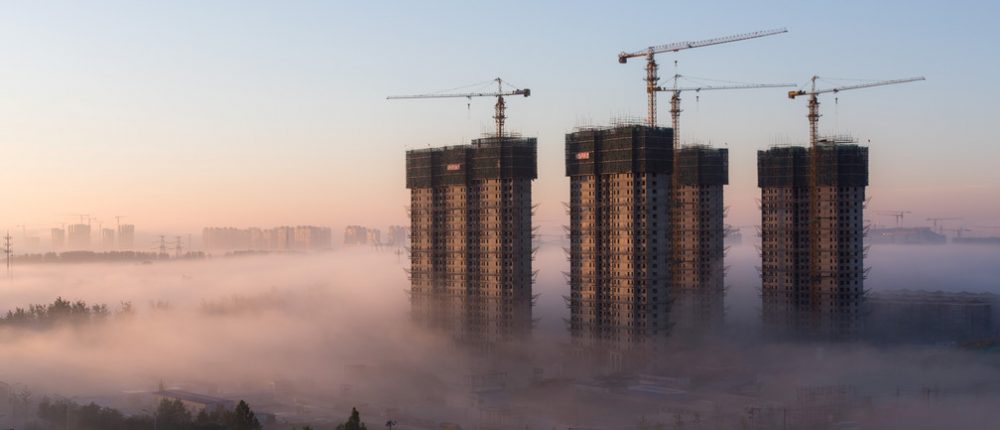China - clean, green buildings of the future
China is the largest building construction market in the world, with up to 2 billion sq. m constructed annually, accounting for nearly half of new construction globally in the coming decade.
In 2011, buildings accounted for just 28% of China’s energy consumption, but urbanisation, economic growth and rising population could increase this number by as much as 40% over the next 15 years. The adoption of green building technologies and solutions is a key part of China’s sustainability and environmental protection goals.
China’s 13th Five Year Plan for Building Energy Efficiency and Green Building Development includes aggressive goals for green building construction and renovation, including a requirement for 50% of all new urban buildings to be certified green buildings. The plan also specifies pilot programmes for constructing and renovating energy efficient primary and secondary schools, community hospitals and public buildings.
As the national Five Year Plan is cascaded to provincial and municipal jurisdictions, nearly 20 cities have set even more ambitious targets. For example, Changde, Zhenjiang, Zibo, Wuxi, and Suzhou, Shanghai, Beijing, Shenzhen, and Chongqing will require all new commercial buildings to be green buildings. In the pursuit of even more sustainable buildings, more than 90% of China’s commercial building owners plan to have at least one net or near-zero energy building in the next ten years.
National plans, policies and targets are important drivers of investment and improvement. Still, significant challenges remain in implementation at a city and district level, such as training, business models, financial solutions and access to information.
Public-private partnerships continue to be one of the most effective ways of overcoming these barriers. The East Asia launch of the Building Efficiency Accelerator (BEA), a global public-private partnership coordinated by the World Resources Institute (WRI), was held at the Thirteenth International Conference on Green and Energy-Efficient Building in Beijing.
The launch included government, private-sector and civil society stakeholders and showcased the building efficiency policy best practices of three leading Chinese districts – Changning District, Wuxi City High-Tech Industrial Development Zone and Suzhou Taihu New City, as well as the BEA partner cities of Ulaanbaatar, Mongolia and Iskandar, Malaysia.
The Changning District deployed an energy monitoring platform that now tracks 160 of the district’s 165 public buildings. To date, 32 buildings have been retrofitted to achieve an average 20% energy saving. The district also provided subsidies to building managers, which in turn encouraged building managers to invest an additional 140 million yuan (US$20.33 million) to improve building efficiency.
Wuxi City High-Tech Industrial Development Zone provided incentives for new buildings that are certified to the US Green Building Council’s LEED or China’s national three-star rating systems. Buildings that achieve the highest green building ratings in either certification program receive up to 500,000 yuan with similar incentives provided for the use of heat pumps, solar photovoltaic systems, and other clean energy technologies.
The Suzhou Taihu New City will house 200,000 residents and all buildings will be designed to receive at least a two-star rating from China’s three-star rating system. The city will also boast a green building demonstration area, constructing several projects like zero-energy schools and monitoring of the building’s energy performance.
Another important public-private partnership is the US-China CERC Building Energy Efficiency (CERC-BEE) consortium. This is a collaborative partnership between leading US and Chinese researchers at national laboratories, research institutes, universities and 48 industry partners, to advance the state-of-the-art in low-carbon and near zero energy buildings.
The new Johnson Controls Headquarters Asia Pacific will be a living laboratory for the company’s CERC-BEE research activities focused on advanced energy monitoring and control, indoor air quality management and building-to-grid integration. Finally, the facility will be used to convene public roundtables and forums to share industry best practices that can help local and provincial governments in China and across the region accelerate their urban efficiency initiatives.
As cities grow, those of us in the buildings space – be it the public or private sector – have an obligation to work together to implement green building technologies and solutions. It’s an effective solution to rising concerns over sustainability and environmental protection, particularly in high-growth markets like China.
This article was written by Alex Molinaroli, Chairman and CEO, Johnson Controls, is a Co-Chair of the Annual Meeting of the New Champions 2017.
Please find the original article here
--Future of Construction 14:13, 04 Jul 2017 (BST)
[edit] Related articles on Designing Buildings Wiki
- 3 ways the fastest growing economies can close the infrastructure gap.
- BRE China celebrates two major milestones.
- China’s New Silk Road - what you need to know.
- Chinese Wallpaper in Britain and Ireland.
- Green building.
- Leadership in Energy and Environmental Design LEED.
- Sustainability in building design and construction.
- These giant infrastructure projects are set to reshape Africa.
- Top 4 challenges facing the construction industry.
- Why the West has to join the Belt and Road Initiative.
Featured articles and news
Homes England supports Greencore Homes
42 new build affordable sustainable homes in Oxfordshire.
Zero carbon social housing: unlocking brownfield potential
Seven ZEDpod strategies for brownfield housing success.
CIOB report; a blueprint for SDGs and the built environment
Pairing the Sustainable Development Goals with projects.
Types, tests, standards and fires relating to external cladding
Brief descriptions with an extensive list of fires for review.
Latest Build UK Building Safety Regime explainer published
Key elements in one short, now updated document.
UKGBC launch the UK Climate Resilience Roadmap
First guidance of its kind on direct climate impacts for the built environment and how it can adapt.
CLC Health, Safety and Wellbeing Strategy 2025
Launched by the Minister for Industry to look at fatalities on site, improving mental health and other issues.
One of the most impressive Victorian architects. Book review.
Common Assessment Standard now with building safety
New CAS update now includes mandatory building safety questions.
RTPI leader to become new CIOB Chief Executive Officer
Dr Victoria Hills MRTPI, FICE to take over after Caroline Gumble’s departure.
Social and affordable housing, a long term plan for delivery
The “Delivering a Decade of Renewal for Social and Affordable Housing” strategy sets out future path.
A change to adoptive architecture
Effects of global weather warming on architectural detailing, material choice and human interaction.
The proposed publicly owned and backed subsidiary of Homes England, to facilitate new homes.
How big is the problem and what can we do to mitigate the effects?
Overheating guidance and tools for building designers
A number of cool guides to help with the heat.
The UK's Modern Industrial Strategy: A 10 year plan
Previous consultation criticism, current key elements and general support with some persisting reservations.
Building Safety Regulator reforms
New roles, new staff and a new fast track service pave the way for a single construction regulator.
























